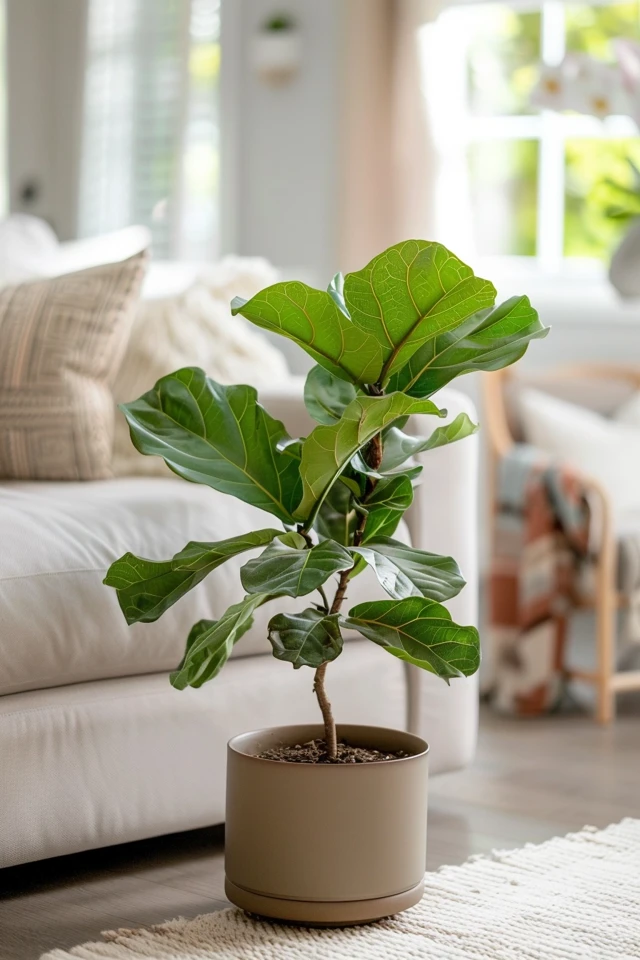Root rot can be a devastating problem for fiddle leaf fig plants, but with the right treatment, you can nurse your plant back to health. Root rot occurs when the roots become infected due to overwatering, causing them to become wet, brown, and mushy. To save your fiddle leaf fig from root rot, it’s crucial to act quickly and follow these recovery steps.
First, remove the plant from its pot and examine the root ball. If the roots are wet, brown, and mushy, they are likely infected with root rot. Take this opportunity to rinse off the root ball and carefully trim away any damaged roots. This will help prevent further spread of the infection.
Next, repot your plant in a container with excellent drainage and fast-draining soil. This will ensure that excess water doesn’t linger around the roots, preventing future root rot. Make sure to place the plant in a well-lit area with indirect sunlight and water it only when the roots have had a chance to dry out.
In addition to these recovery steps, consider using a root rot treatment to protect your fiddle leaf fig from future infections. This can help strengthen the plant’s immune system and prevent the recurrence of root rot.
Key Takeaways:
- Root rot in fiddle leaf fig plants is caused by overwatering and leads to wet, brown, and mushy roots.
- Act quickly by removing the plant from its pot, rinsing off the root ball, and trimming away damaged roots.
- Repot the fiddle leaf fig in a container with excellent drainage and fast-draining soil to prevent future root rot.
- Ensure the plant receives enough light and water it only when the roots have dried out to aid in its recovery.
- Consider using a root rot treatment to protect your fiddle leaf fig from future infections.

Diagnosing Root Rot in Fiddle Leaf Fig Trees
Diagnosing root rot in fiddle leaf fig trees can be challenging as the symptoms may not be immediately obvious. Common signs include brown spots on the leaves, dropping leaves, and a damp, unpleasant smell around the plant.
To confirm if your fiddle leaf fig has root rot, you need to inspect the roots. Wet, soggy, or mushy brown roots, dripping or soaked soil, and an unpleasant smell in the soil are clear indicators of root rot.
If you suspect root rot, it’s important to take action quickly to save your plant. Remove the plant from its pot, rinse off the roots, and trim away any damaged roots. Repot the plant in a container with proper drainage and fast-draining soil.
Let the plant recover in bright, indirect light and water it only when the roots have dried out. Be patient and give your fiddle leaf fig the time it needs to stabilize and recover.
Preventing Root Rot in Fiddle Leaf Fig Plants
Prevention is key when it comes to keeping your fiddle leaf fig plants healthy and free from root rot. By following these care tips, you can minimize the risk of root rot and ensure your plants thrive:
- Provide Adequate Light: Fiddle leaf figs need bright, indirect light to grow properly. Place your plant near a window where it can receive ample natural light throughout the day.
- Water Wisely: Only water your fiddle leaf fig when the top inch of soil has dried out. Overwatering is the leading cause of root rot, so be mindful of how much water you give your plant. Consider using a moisture meter or your finger to check the soil’s moisture level before watering.
- Establish a Watering Schedule: Create a consistent watering schedule based on the specific needs of your fiddle leaf fig. Factors such as plant type, pot size, soil type, sunlight intensity, and season should be considered. This will help prevent overwatering and ensure that the plant’s roots have enough time to dry out between watering sessions.
- Choose a Well-Draining Pot: Select a pot with proper drainage to allow excess water to escape easily. Look for pots with drainage holes at the bottom. If you prefer to use decorative pots without drainage, place a plastic pot with drainage holes inside it to protect your plant from waterlogging.
- Use Fast-Draining Soil: When repotting your fiddle leaf fig, opt for a fast-draining soil mix that promotes healthy root growth. You can enhance drainage by adding gravel or a foam block at the bottom of the pot.
By following these preventive measures, you can significantly reduce the risk of root rot in your fiddle leaf fig plants. Remember, a little extra care goes a long way in keeping your plants happy and thriving.

Conclusion
Root rot is a serious issue that can affect the health and vitality of your fiddle leaf fig plant. If you suspect your plant has root rot, it’s crucial to take immediate action to give it the best chance of recovery. By following the recovery steps outlined in this Fiddle Leaf Fig root rot recovery guide, you can help your plant overcome this condition and thrive once again.
Start by removing the plant from its pot and thoroughly inspecting the roots. Rinse off the roots and trim away any damaged or mushy sections. Repot the plant in a container with good drainage and fast-draining soil to prevent further moisture accumulation. Ensure your fiddle leaf fig gets adequate sunlight and water it sparingly, allowing the roots to dry out between waterings.
With patience and proper care, your fiddle leaf fig can bounce back from root rot. Be vigilant and continue to monitor your plant’s health, addressing any issues promptly. By implementing the recovery steps and maintaining a healthy care routine, you can enjoy the beauty of your fiddle leaf fig for years to come.

